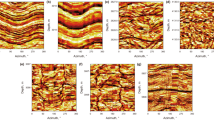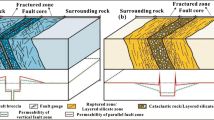Abstract
The existence of fractures and vugs in igneous formation is a key factor to determine the productivity of oil and gas reservoirs. Fracture–vug plane porosity and porosity spectrum (fracture–vug parameters) are important parameters to evaluate the development of fractures and vugs. In the process of drilling, the bit forms shallow holes and scratches on the borehole wall which is characterized by pitting, strip and block noise in the electrical imaging logging static image. The background noise affects the identification of fractures and vugs and the extraction of parameters. It is found that the background noise mainly exists in the high-frequency conductivity data. In order to suppress the background noise, empirical mode decomposition is applied to conductivity data of electrical imaging logging, and the wavelet hard threshold de-noising is applied to high-frequency intrinsic mode function components. The de-noising fracture–vug parameters have a good correspondence with the electrical imaging logging static image, and have a better linear relationship with the core porosity. These illustrate that the application of the de-noising method in the electrical imaging logging is reasonable and effective. The de-noising porosity spectrum becomes narrower in the reservoir with poor fractures and vugs, which can reveal the development of secondary pores more clearly. In reservoir interpretation, the de-noising fracture–vug plane porosity and porosity spectrum have good consistency with conventional and acoustic logging data, which can effectively evaluate the fractures and vugs in reservoirs.











Similar content being viewed by others
References
Al-Qazzaz NK, Bin MASH, Ahmad SA, Islam MS, Escudero J (2015) Selection of mother wavelet functions for multi-channel EEG signal analysis during a working memory task. Sensors (Basel, Switzerland) 15:29015–29035
An Y (2012) MATLAB-based wavelet analysis for seismic signal de-noising research. China, Zhong Bei University
Bommisetty RM, Prakash OB, Khare A (2020) Keyframe extraction using Pearson correlation coefficient and color moments. Multimed Syst 26:267–299
Chitale DV, Quirein J, Perkins T (2004) Application of anew borehole imager and technique to characterize secondary porosity and net-to-gross in vugular and fractured carbonate reservoirs in Permian Basin. 45th SPWLA Annual Logging Symposium. Paper, RR.
Cohen J (1988) Statistical power analysis for the behavioral sciences, 2nd edn. Lawrence Erlbaum Associates, Hillsdale, NJ, p 83
Daubechies I (1988) Orthonormal bases of compactly supported wavelets. Commun Pure Appl Math 41:909–996
Daubechies I (1993) Orthonormal bases of compactly supported wavelets II: variations on a theme. SIAM J Math Anal 24:499–519
Deborah JR (2011) Statistics for dummies, 2nd edn. Wiley Publishing, Hoboken, NJ, p 284
Delhomme JP (1992) A quantitative characterization of formation heterogeneities based on borehole image analysis. 33th SPWLA Annual Logging Symposium, Oklahoma Paper: T
Ekstrom MP, Dahan CA, Chen MY, Lloyd PM, Rossi DJ (1987) Formation imaging with microeletrical scanning arrays. Log Anal 28:294–306
Huang NE (1988) The empirical mode decomposition and the Hilbert spectrum for nonlinear and non-stationary time series analysis. Proc R Soc Lond Ser A 454:903–995
Huang NE, Shen Z, Long SR (1999) A new view of nonlinear water waves: the hilbert spectrum. Annu Rev Fluid Mech 31:417–457
Hao ZM, Xu GM, Chen HD, Wang QX, Long K, Wang WK, Wang Q (2020) Pore classification and thin section porosity quantification of reservoir in the T2l4(3) in Majing area, Western Sichuan Basin. Oil Gas Geol 41:380–392
Jiang L, Li CY (2005) A study of wavelet threshold filtering based on empirical model decomposition. Signal Process 21:659–662
Lemarié-Rieusset PG, Meyer Y (1986) Ondeletteset bases hilbertiennes. Rev Mat Iberoam 2:1–18
Li QS, Pan HP, Zhang R (2005) The progess of resistivity imaging log. Chin J Eng Geophys 2:304–310
Li CY, Lian JJ, Liu F, Ma B (2013) An improved filtering method based on EMD and wavelet-threshold and its application in vibration analysis for a flood discharge structure. J Vib Shock 32(63–70):110
Li XN, Shen JS, Li ZL, Luo AY, Ma C, Zhang WW, Ye WJ, Zhu ZM (2017) Characterization of reservoir fracture and vug parameters by conductivity image of FMI based on multi-scale mathematical morphology method. J China Univ Pet (Ed Nat Sci) 41:69–77
Lin J, Fu MY, Li DP (2011) Self-adaptive wavelet threshold de-noising method and its application in image processing. Acta Armament 32:896–900
Liu RL, Xie F, Xiao CW, Zhang LL (2017a) Extracting fracture-vug plane porosity from electrical imaging logging data using dissection of wavelet-transform-based image. Chin J Geophys (in Chinese) 60:4945–4955
Liu ZL, Wang ZW, Zhou DP, Zhao SQ, Xiang M (2017b) Pore distribution characteristics of the igneous reservoirs in the Eastern Sag of the Liaohe depression. Open Geosci 9:161–173
Luthi SM (2001) Geological well logs: their use in reservoir modeling. Springer- Verlag, New York, pp 98–118
Ou WM, Wang ZW, Ning QQ, Yu Y, Xu FH (2019) Numerical simulation of borehole Stoneley wave reflection by a fracture based on variable grid spacing method. Acta Geophys 67:1119–1129
Parra J, Hackert C, Richardson E, Clayton N (2009) Porosity and permeability images based on crosswell seismic measurements integrated with FMI logs at the Port Mayaca aquifer, South Florida. Lead Edge 28:1212–1219
Safinya KA, Le P, Villegas M, Cheung PS (1991) Improved formation imaging with extended microeletrical arrays. 66th Ann Conf Soc Petrol Eng. Paper 22726.
Shao RP, Cao JM, Li YL (2012) Gear fault pattern identification and diagnosis using time-frequency analysis and wavelet threshold de-noising based on EMD. J Vib Shock 31(96–101):106
Stadtmuller M (2019) Well logging interpretation methodology for carbonate formation fracture system properties determination. Acta Geophys 67:1933–1943
Wang ZW, Liu JH, Nie CY (2008) Time-frequency analysis of array acoustic logging waveform signal based on Hilbert-Huang transform. Earth Sci J China Univ Geosci 33:387–392
Wang XC, Li J, Zhang SY, Tan MJ, Guzhalikezi YM (2011a) Numerical simulation and application of fracture surface porosity calibrating fracture porosity by logging data. J China Univ Pet (Ed Nat Sci) 35:51–56
Wang XC, Li J, Zhang SY, Tan MJ (2011b) Quantitative characterization and calibration of fracture pore parameters and the effect factors analysis. Prog Geophys 26:393–1399
Wang L, Fan YR, Gao YW, Fan ZY, Wu ZG (2017) Numerical simulation and characteristics analysis of dual laterolog in cavernous reservoirs on the basis of 3D-FEM. Chin J Geophys 60:2011–2019
Wilson MEJ, Lewis D, Yogi O, Holland D, Hombo L, Goldberg A (2013) Development of a papua new guinean onshore carbonate reservoir: a comparative borehole image (FMI) and petrographic evaluation. Mar Pet Geol 44:164–195
Xiao XL, Jin XJ, Zhang X, Liu HL, Jiang YW (2015) Fracture identification based on information fusion of conventional logging and electrical imaging logging. Oil Geophys Prospect 50:542–547
Xiao K, Zou CC, Shang JT, Zhou XP (2018) Application of ultrasonic imaging log technology of scientific drilling boreholes in Nanling district. Sci Technol Eng 18:72–78
Xie F, Xiao CW, Liu RL, Zhang LL (2017) Multi-threshold de-noising of electrical imaging logging data based on the wavelet packet transform. J Geophys Eng 14:900–908
Xu FH, Wand ZW, Liu JH, Ou WM (2020) Application of de-noising method on electrical imaging logging data based on joint EMD and wavelet threshold. J China Univ Pet (Ed Nat Sci) 44:56–65
Xu FH, Wang ZW (2020) Numeric simulation of acoustic-logging of cave formations. Energies 13:3908
Yan JP, Liang Q, Li ZZ, Geng B, Kou XP, Hu Y (2016) A connected domain identification method and it application in quantitatively pick up information of caves using electric imaging logging. Chin J Geophys (in chinese) 59:4759–4770
Zhao J, Qi XZ, Liu RL, Zhong GF (2007) The object picking and calculating by image devision for the image log data. Progress Geophys 22:1502–1509
Zhang XF, Pan BZ (2012) Two-dimensional wavelet transform to identify fractures in imaging logging. Oil Geophys Prospect (in Chinese) 47:173–176
Zhou YQ, Li XH, Fan XM (2014) A comparative study of porosity spectrum techniques of micro-electric imaging logging and core analysis of porosity. Well Logging Technol 38:309–314
Zhu JC, Zou CC (2017) The study on boundary effect of wavelet transform with well logging data. Chin J Eng Geophys 14:105–110
Zuo CJ, Wang ZW, Xiang M, Zhou DP, Liu ZL, Yang F (2016) The radial pore heterogeneity of volcanic reservoir based on the porosity analysis of micro-electric imaging logging. Geophys Prospect Pet 55:449–454
Acknowledgments
The work described in this paper is supported by the National Natural Science Foundation of China (No. 41874135 and No. 41790453) and the National Key R&D Program of China (2019YFC0605402).
Funding
This research was funded by the National Natural Science Foundation of China (No. 41874135 and No. 41790453) and the National Key R&D Program of China (2019YFC0605402).
Author information
Authors and Affiliations
Contributions
FX is the main author of this manuscript and Wenhua Wang did a lot of experiments. This work was conducted under the advisement of ZW and ZW reviewed the manuscript and made contributions to its structure.
Corresponding author
Ethics declarations
Conflicts of interest
The authors declare no conflicts of interest.
Additional information
Communicated by Jadwiga Anna Jarzyna, prof (ASSOCIATE EDITOR)/Michal Malinowski (CO-EDITOR-IN-CHIEF).
Rights and permissions
About this article
Cite this article
Xu, F., Wang, Z. & Wang, W. Evaluation of fractured–vuggy reservoir by electrical imaging logging based on a de-noising method. Acta Geophys. 69, 761–772 (2021). https://doi.org/10.1007/s11600-021-00558-w
Received:
Accepted:
Published:
Issue Date:
DOI: https://doi.org/10.1007/s11600-021-00558-w




